Corn snakes exhibit an exciting diversity in color and pattern due to specific genetic changes and thoughtful breeding. From the riveting Amelanistic to the striking Snow morphs, they present an array of choices for those wanting a delightful snake companion. Yet, not all corn snakes are created equal for novice reptile keepers. The calm nature and minimal care demands of Amelanistic, Anerythristic, and Snow morphs make them favored selections for novices dipping their toes in the fascinating world of herpetology. Now, let’s embark on our journey through these vast landscapes of corn snake varieties.
Corn snakes come in a wide range of types, including Amelanistic (Amel), Anerythristic (Anery), Butter, Bloodred, and Snow, each exhibiting unique colors and patterns due to specific genetic mutations. For example, the Ultramel morph was introduced from Grey Ratsnakes, resulting in distinctive coloration.
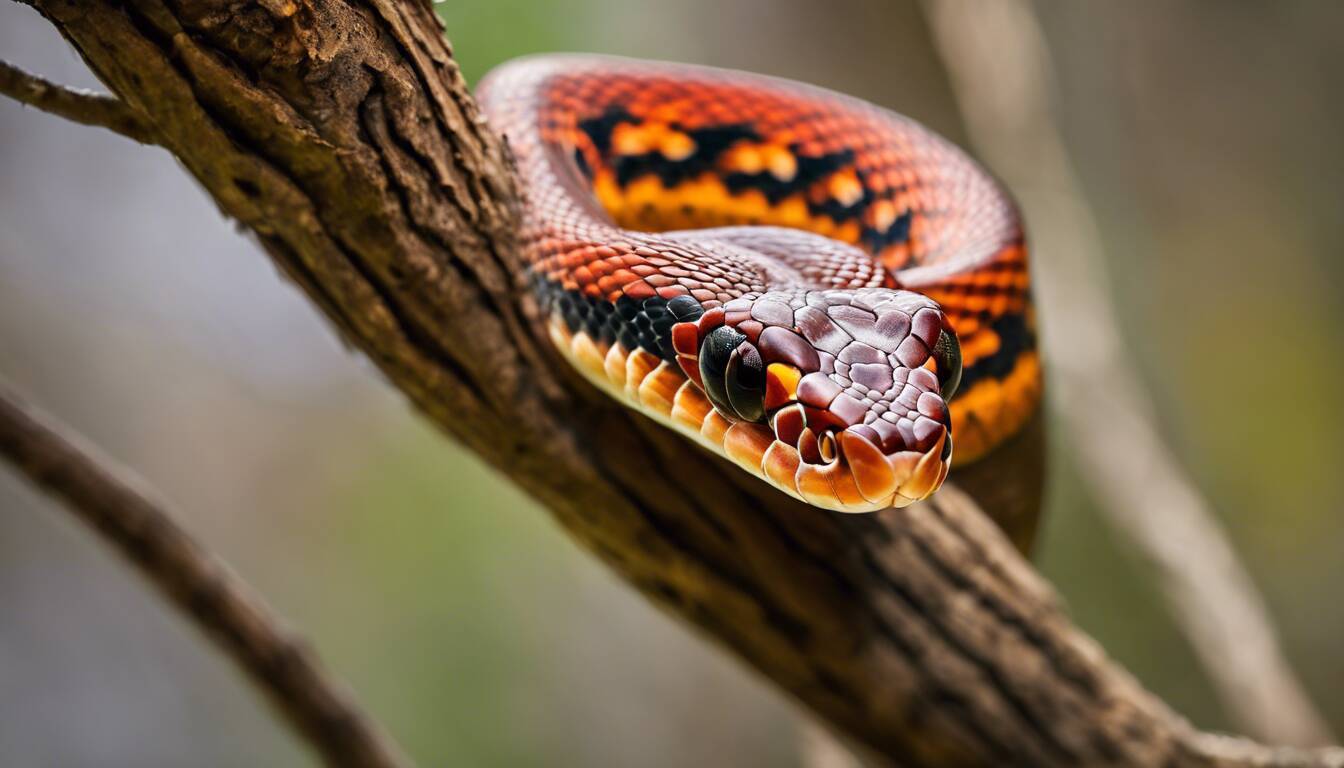
Identifying Types of Corn Snakes
For those captivated by the world of corn snake variations, it’s essential to understand how to recognize the different types available. With an extensive range of colors, patterns, and morphs, navigating the world of corn snakes can be quite enchanting. Each type has distinct characteristics that set it apart, making the selection process engaging and rewarding.
Different Breeds and Their Distinct Characteristics
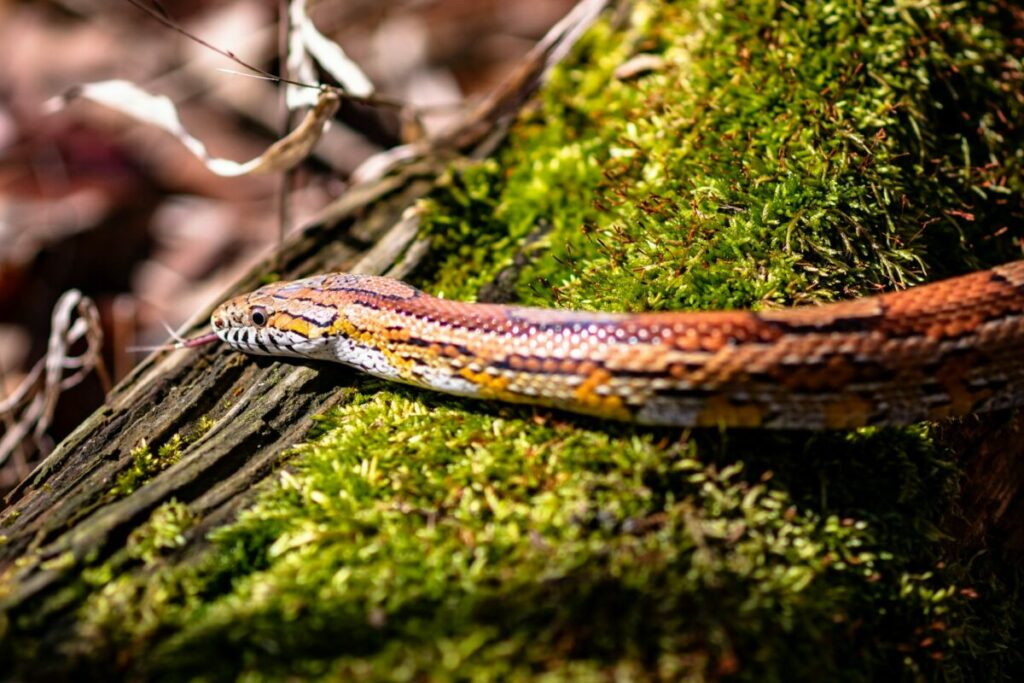
The wide variation in breeds offers prospective snake owners a multitude of choices. Some breeds are known for their vivid primary colors, while others boast intricate secondary hues that add depth to their appearance. Understanding these breed-specific traits is crucial for enthusiasts looking to acquire a corn snake that aligns with their aesthetic preferences.
See Related: Lavender Albino Corn Snake Care: A Complete Guide for Reptile Lovers
Color Variations Within Each Breed
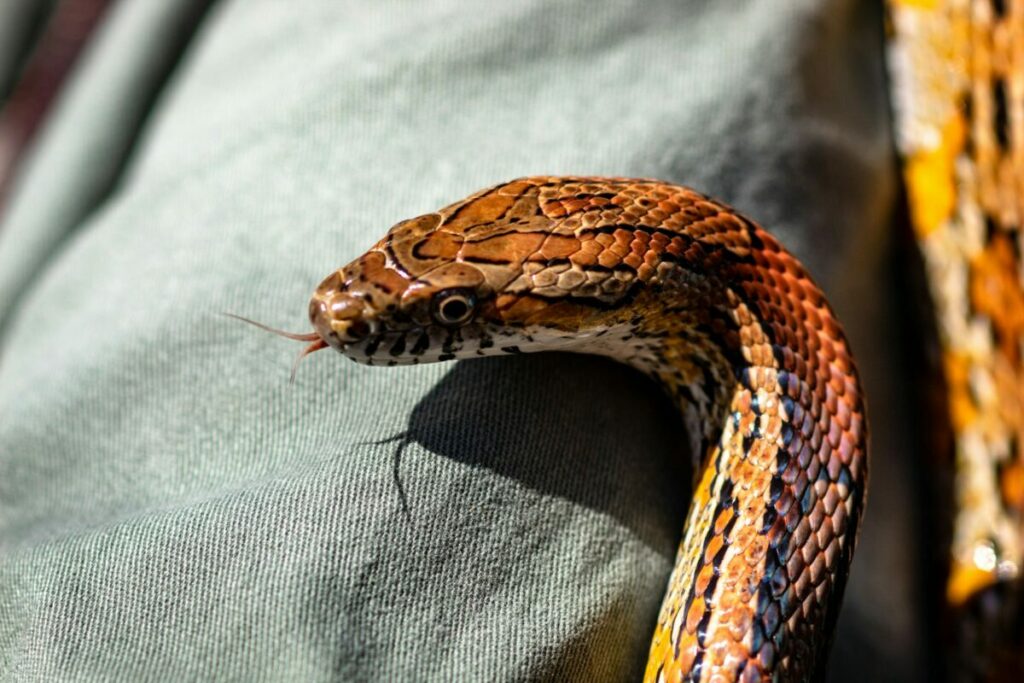
Entering the world of corn snakes reveals a spectrum of color variations within each breed, presenting visually appealing and distinctive features. From striking reds and oranges to captivating blues and purples, the array of colors provides a visual feast for enthusiasts, distinguishing one type from another.
See Related: Okeetee Corn Snake: A Comprehensive Guide to Breeding, Care, and Colors
Patterns Found on the Skin of Corn Snakes
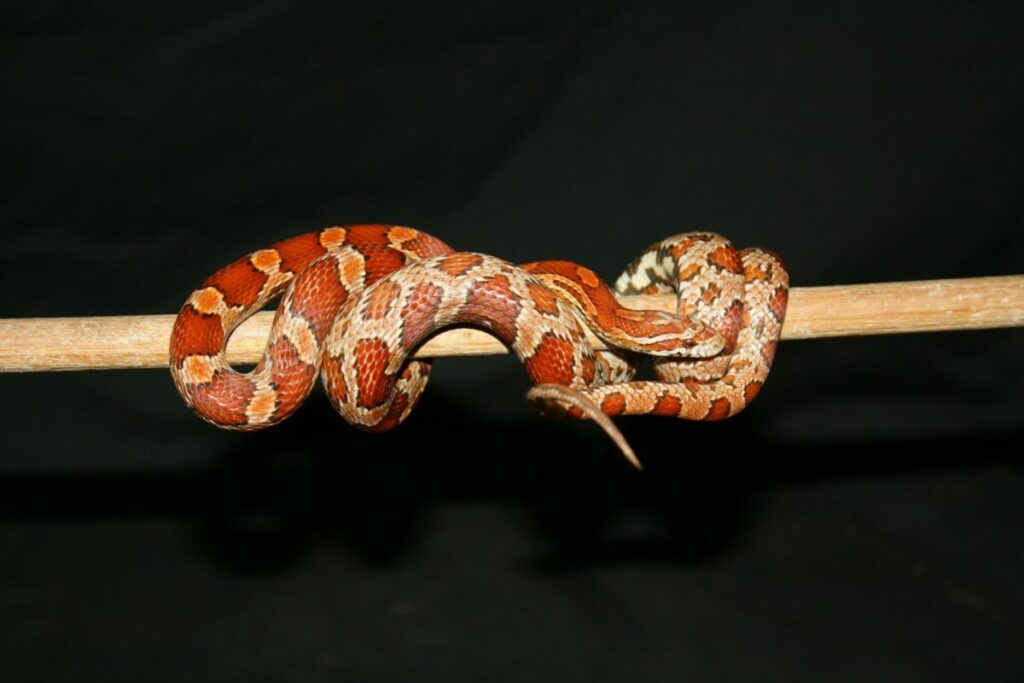
One cannot overlook the captivating patterns adorning the skin of corn snakes. Whether it’s bold stripes, intricate blotches, or mesmerizing motley patterns, these visual elements significantly contribute to the allure of each snake. Understanding these patterns and appreciating their intricate beauty is fundamental in discerning and appreciating the diverse types of corn snakes available.
See Related: Understanding Corn Snake Bite Marks: Symptoms, Treatment, and Healing
Behavioral Differences Between Various Breeds
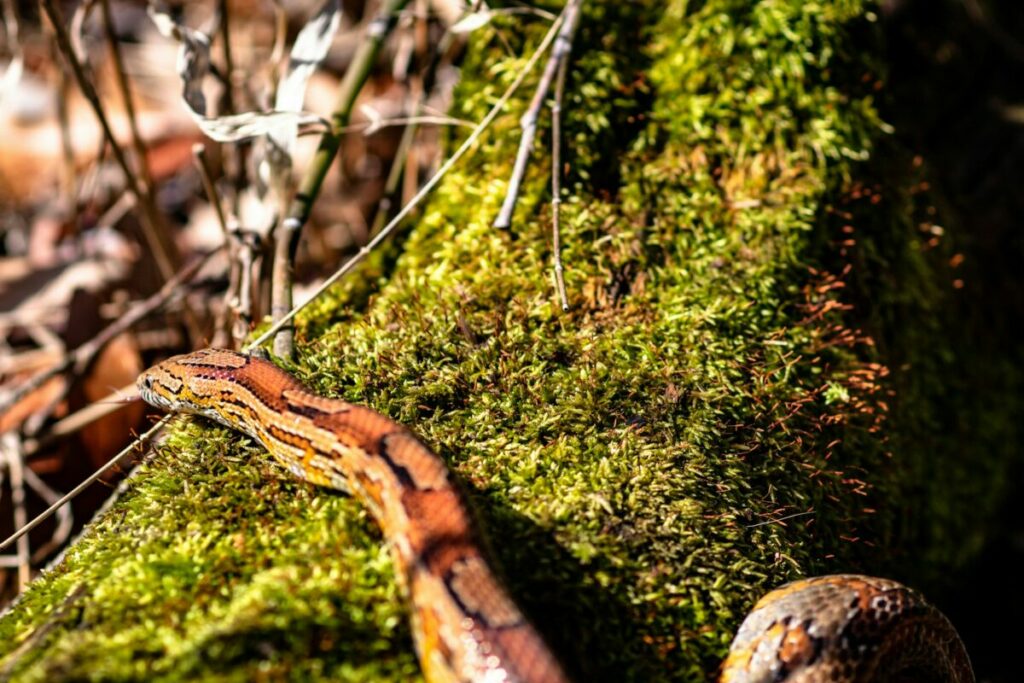
Amidst discussions about color and pattern, behavioral differences also play a pivotal role in identifying various types of corn snakes. While some breeds may exhibit more reserved demeanors, others may display bold and explorative tendencies. Understanding these behavioral nuances provides insight into the unique personalities associated with different types of corn snakes, enriching the selection process for potential owners.
As we immerse ourselves in this rich tapestry of colors, patterns, and behaviors exhibited by various types of corn snakes, it’s apparent that each type offers a distinctive experience. By grasping the nuanced characteristics encapsulated within each breed, enthusiasts are equipped to make informed decisions when selecting a pet corn snake that resonates with their preferences and aligns with their lifestyle.
Stepping further into our exploration of the captivating realm of corn snakes leads us to uncover which species are ideal for beginners looking to venture into snake ownership.
Best Corn Snake Species for Beginners
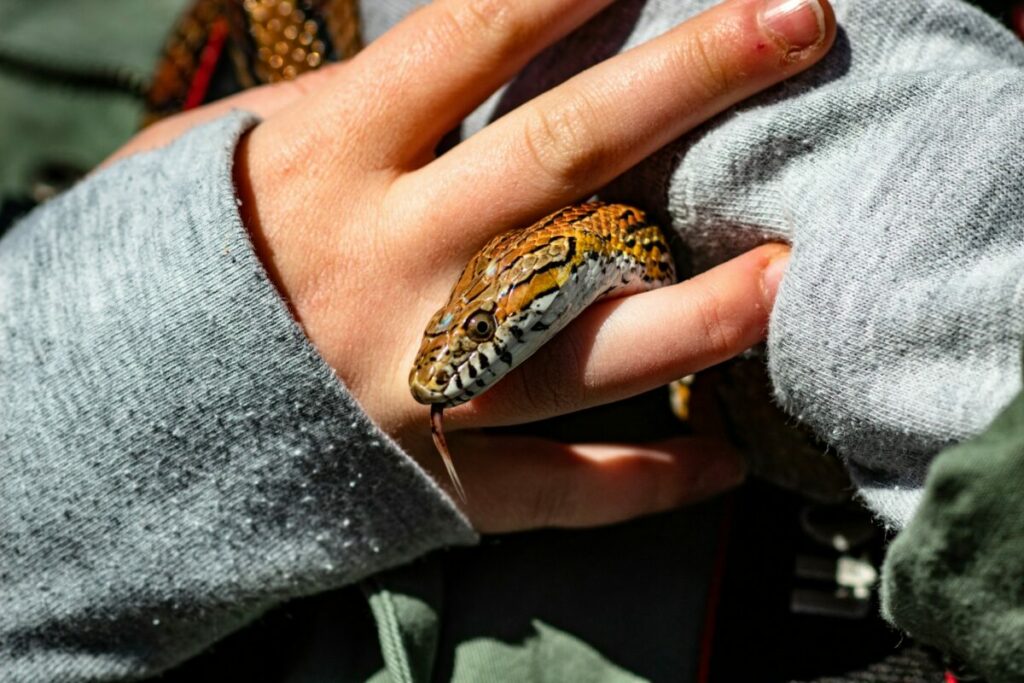
When choosing a corn snake as your first reptile pet, certain factors need consideration to ensure a smooth and enjoyable experience. From temperament to care requirements, specific species are more suitable for novice snake owners.
For beginners, it’s essential to look for corn snake species that are inherently docile and easy to handle. Amelanistic, Anerythristic, and Snow morphs are excellent choices in this regard. Their calm and gentle demeanor makes them well-suited for those who are new to snake handling. The last thing you want is an aggressive or high-strung snake that will make your first reptile experience stressful.
Moreover, these beginner-friendly corn snake species have simple care needs, making them relatively low-maintenance pets. This is especially beneficial for individuals who are new to reptile care and may feel overwhelmed by complex husbandry requirements. With these species, you can focus on bonding with your snake and familiarizing yourself with snake care without feeling burdened by intricate routines right from the start.
Imagine having a pet that doesn’t require overly specific environmental conditions or dietary preferences that are difficult to meet. It can simplify the learning process and provide a positive introduction to reptile ownership.
Furthermore, selecting an easy-to-care-for corn snake species allows beginners to build confidence in their ability to provide adequate care for a pet reptile. Feeling successful in caring for a seemingly challenging pet like a snake can be incredibly rewarding for first-time reptile owners.
In summary, Amelanistic, Anerythristic, and Snow morphs stand out as the best corn snake species for beginners due to their gentle nature, simple care requirements, and the positive and enriching experience they offer to novice reptile enthusiasts.
As you step into the fascinating world of different corn snake patterns and variations, let’s unravel the captivating allure of Striped Corn Snakes Explained.
Striped Corn Snakes Explained
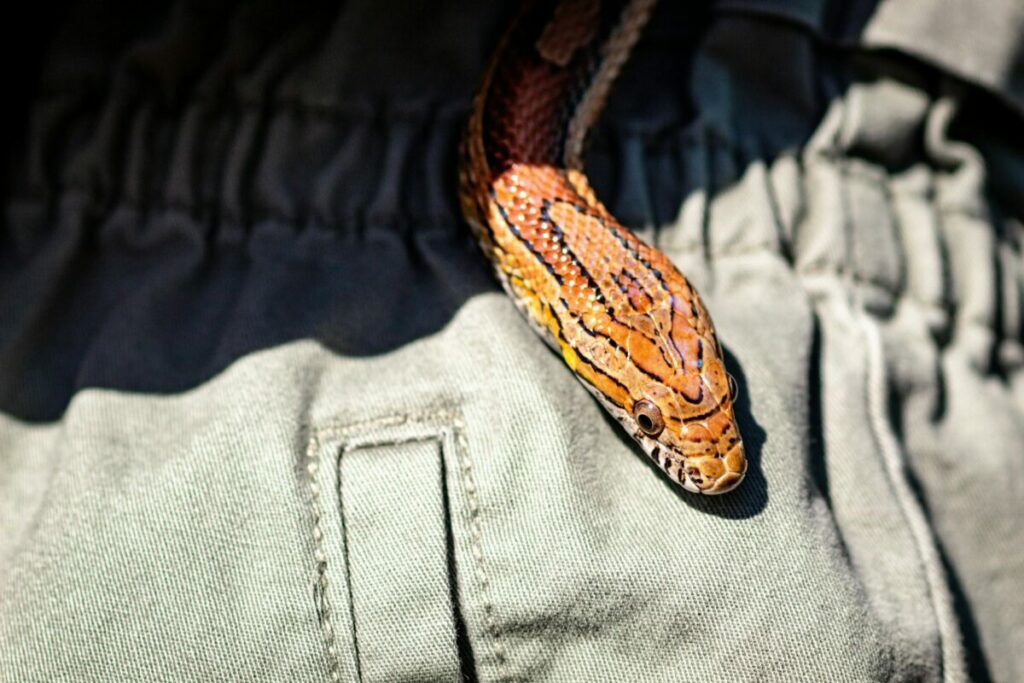
Striped corn snakes are truly mesmerizing creatures with a striking appearance. The prominent stripes that run along their bodies give them a unique and eye-catching look, varying in intensity and width, making each snake distinct. Whether it’s the result of natural pattern variation or genetic mutation, the allure of striped corn snakes is undeniable.
Natural striping in corn snakes is awe-inspiring on its own, but what sets striped corn snakes apart is the potential for unique variations resulting from genetic mutations. These mutations can lead to even more visually captivating patterns, elevating the appeal of these already fascinating reptiles. Therefore, striped corn snakes have become highly sought after in the world of reptile enthusiasts and breeders alike.
It’s important to note that while some striped corn snakes exhibit natural striping, others owe their distinct patterns to genetic mutations. These mutations have brought about a wide array of variations, making each striped corn snake display a unique and captivating appearance.
The allure of striped corn snakes also lies in their ability to capture the attention of enthusiasts and collectors due to their captivating appearance. The fascination with these mesmerizing reptiles has driven significant interest in understanding and appreciating the various patterns and mutations that contribute to their beauty. As a result, breeders and enthusiasts have dedicated themselves to preserving and enhancing these intricate patterns through selective breeding and thoughtful conservation practices.
Understanding the allure of striped corn snakes is similar to admiring a diverse art collection, where each piece represents a unique expression of creativity and beauty. Just as art enthusiasts appreciate the nuances and intricacies of different works, reptile enthusiasts celebrate the individuality and charm of each distinct striped corn snake pattern.
One cannot overlook the connection between the appreciation of nature’s beauty through striped corn snakes’ enchanting patterns and the pursuit of preserving their genetic diversity. This ongoing recognition of nature’s artistry underscores the importance of responsible breeding practices aimed at promoting and safeguarding the captivating features that make striped corn snakes truly exceptional.
Moving forward in our exploration, we will delve deeper into the mesmerizing world of striped corn snakes, uncovering the intricate details that make them such sought-after companions for seasoned reptile enthusiasts and first-time owners alike.
In-depth Look at Albino Corn Snakes
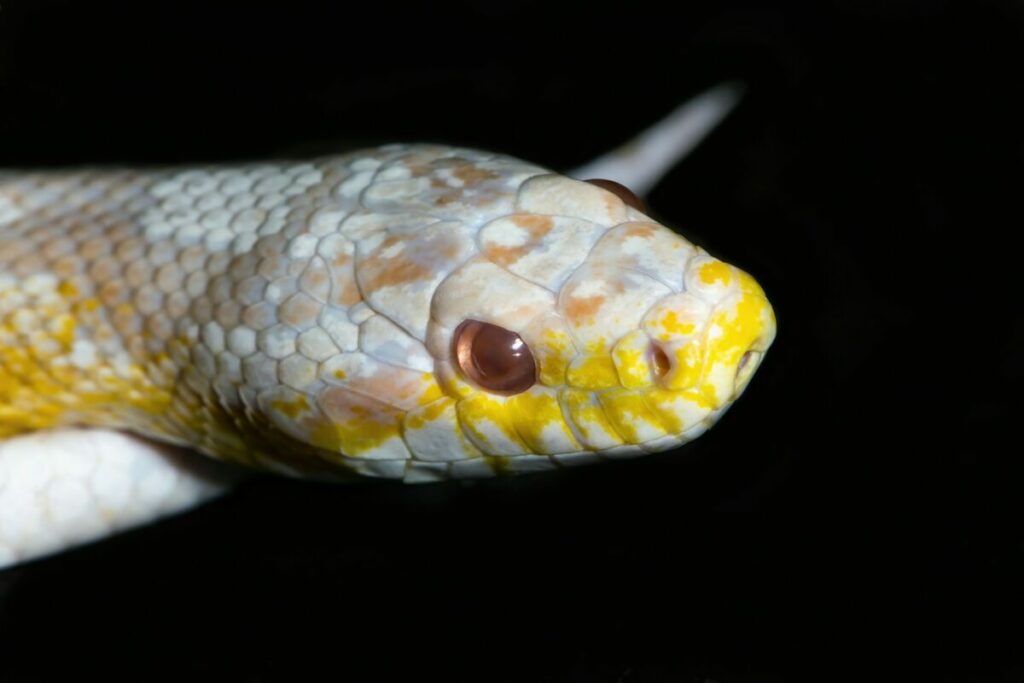
Albino corn snakes are captivating creatures, exhibiting a stunning lack of melanin that results in a distinctive appearance. Their most prominent feature is the absence of dark pigmentation, giving them an overall white or pale yellow background coloration. This striking canvas is adorned with vibrant red or orange blotches, creating a visually arresting contrast that has captivated the attention of enthusiasts and breeders alike.
The genetic significance of albino corn snakes within the breeding community cannot be overstated. The absence of melanin in albino corn snakes is the result of a recessive genetic mutation, making them particularly valuable for selective breeding programs. When bred with another albino snake or a carrier of the albino gene, these snakes produce offspring with the coveted albino phenotype. This genetic characteristic has elevated the importance of albino corn snakes within the realm of corn snake breeding, contributing to the diversity and beauty of this species.
Beyond their genetic significance, albino corn snakes have become popular among reptile enthusiasts due to their visually appealing appearance. The unique coloration of albino morphs sets them apart from other varieties of corn snakes, making them prized additions to collections and breeding programs. Their eye-catching pigmentation and distinct lack of melanin have garnered attention and admiration from individuals passionate about reptiles, further cementing their status as sought-after specimens.
It’s important to note that the appeal of albino corn snakes extends beyond their aesthetic allure. Many individuals appreciate these captivating creatures for their docile nature, making them suitable choices for both experienced reptile enthusiasts and first-time pet owners. Their gentle temperament and enchanting appearance make them popular additions to households and breeding facilities alike, enhancing the overall allure and desirability of the albino morph within the corn snake community.
In our exploration of albino corn snakes, we’ve uncovered their mesmerizing appearance, genetic significance, and widespread appeal among enthusiasts and breeders. These distinctive reptiles continue to captivate hearts and minds with their unique charm and significance within the world of corn snake breeding.
Having explored the captivating world of albino corn snakes, it’s time to shift our focus towards understanding the habitat and behavior patterns of wild and outdoor corn snakes.
Wild and Outdoor Corn Snakes
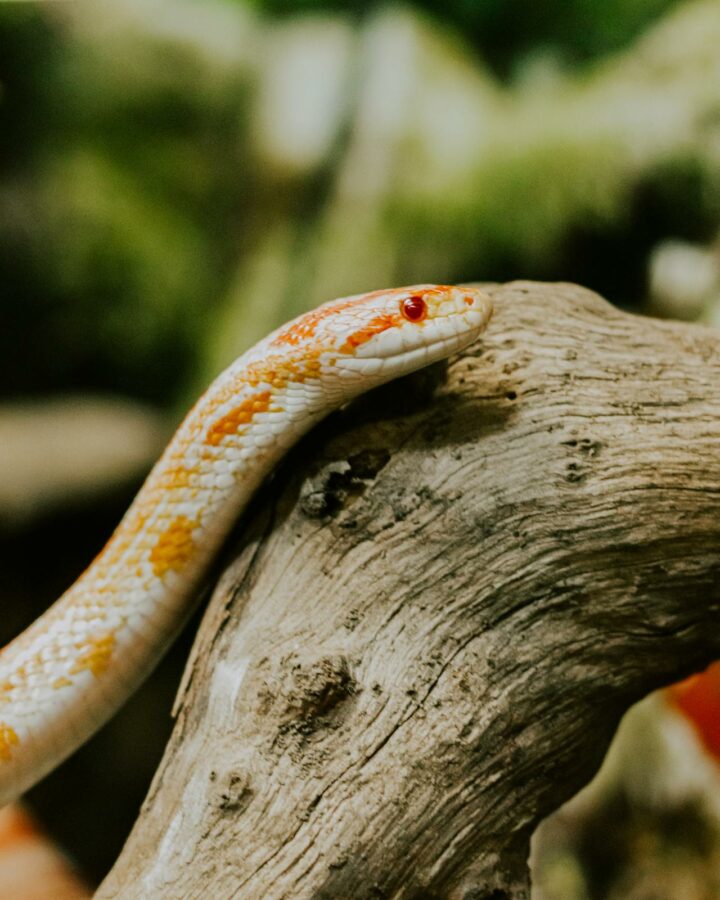
In the southeastern United States, you might stumble upon nature’s very own work of art: the wild and outdoor corn snake. These native residents are a living kaleidoscope – each one has its own unique pattern and colors influenced by their environment. Imagine walking through the woods and spotting a corn snake slithering over vibrant leaves, blending in like a piece of living art.
The natural coloring and pattern variations in these wild corn snakes are affected by their specific geographic location. For example, those found in woodlands might have darker colors – perhaps various shades of brown or black – that help them blend into the forest floor. On the other hand, corn snakes in grassland environments might exhibit brighter tones like orange, red, or yellow that mimic the sun-kissed meadows.
This isn’t just a matter of aesthetics; it’s also an important survival tactic for these reptiles. Their ability to camouflage themselves helps protect them from predators, allowing them to thrive in their natural habitats.
It’s fascinating to think about how each snake’s appearance is shaped by its surroundings. The natural selection process has played a significant role in influencing the diverse visual traits we see in these creatures today. These variations have also been studied and utilized by breeders in breeding programs, further shaping the array of captivating patterns and colors we see in captive-bred corn snakes.
Just like how artists draw inspiration from the world around them, breeders have tapped into nature’s palette to create captivating morphs that capture the essence of these wild and outdoor corn snakes.
Some may argue that manipulating these natural traits through selective breeding can alter the authenticity of wild corn snakes. While there are valid discussions surrounding this practice, the beauty and diversity seen within captive-bred varieties have also led to deeper appreciation and understanding of these magnificent creatures.
Transitional Sentence
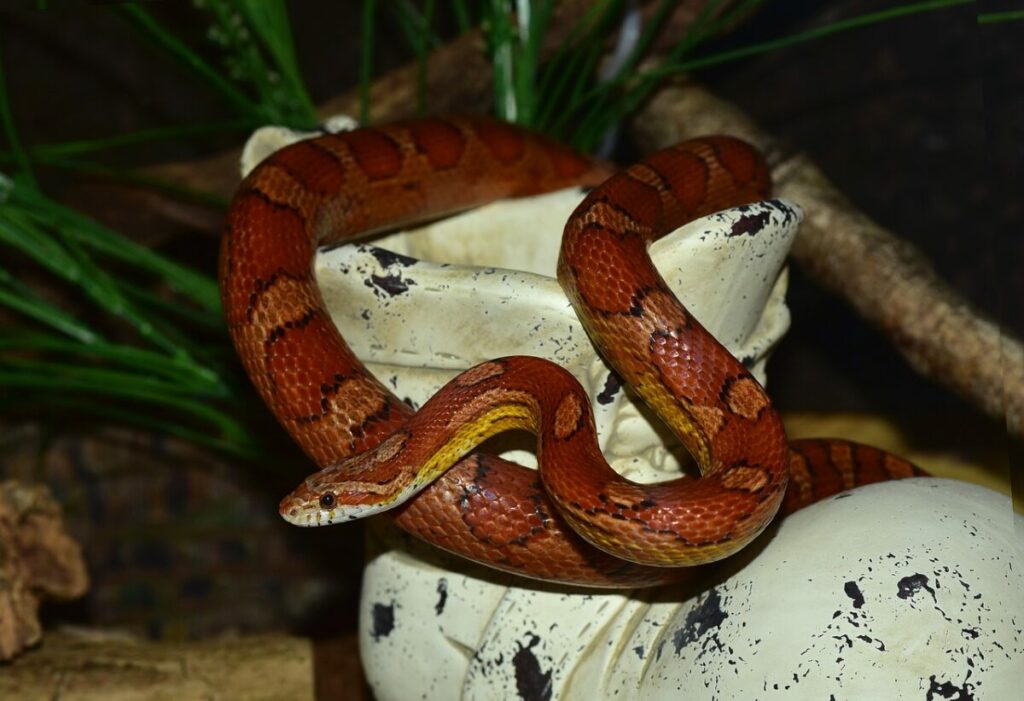
As we witness the vibrant interplay between nature and human intervention in shaping the incredible diversity of corn snake types, let’s now venture into examining how breeding practices have further molded the intricate genetic tapestry of these remarkable reptiles.
Breeding and Genetics of Corn Snakes
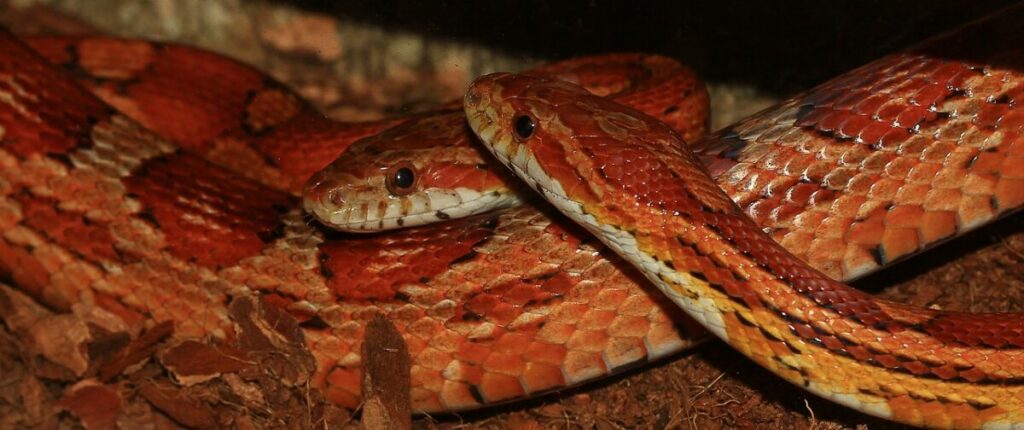
Breeding programs are an essential component of the captivating variety of colors and patterns found in corn snakes. Understanding genetics is crucial to appreciating the wide array of morphs available.
Genetics play a pivotal role in predicting the traits of offspring from parent corn snakes. Each morph, or specific color and pattern variation, is a result of genetic mutations passed down from the parents to their progeny. By meticulously studying these genetic patterns, breeders can anticipate the outcomes when pairing specific individuals, thereby creating new and enticing morphs for pet enthusiasts to select from.
The frequency at which certain color and pattern combinations appear in different breeds is directly influenced by genetic inheritance patterns. This means that some morphs may be more prevalent in certain populations due to natural selection or breeding practices.
For instance, the Ultramel gene mutation was introduced from Grey Ratsnakes to create Ultramel morphs in corn snakes. Similarly, the Miami Phase is a selectively bred polygenetic variation rather than a mutation. These instances underscore the intricate knowledge breeders have about genetic mutations and inheritance, allowing them to manipulate the gene pool to produce desired traits in corn snakes.
The creation of new morphs through breeding requires a deep understanding of genetic inheritance patterns, as well as keen observation and careful record-keeping to ensure successful pairings and predictably stunning results.
Influencing species outcomes through selective breeding isn’t limited to natural mutations alone. It also involves traceable lineage records, detailed observations, and meticulous planning to achieve specific color or pattern traits.
Choosing the Right Corn Snake for You
Choosing a pet is a significant decision, and it’s crucial to find one that fits your lifestyle. When considering corn snakes, there are multiple factors to ponder before welcoming one into your home. The first thing to contemplate is your experience level with snakes. If you’re new to snake ownership or have never had one before, starting with a breed known for being friendly and easy to handle may be beneficial.
Some breeds are more docile and easygoing than others, making them great choices for beginners. For instance, the amelanistic (or amel) morph is known for its friendly disposition and gentle nature, making it an excellent option for first-time snake owners. Conversely, experienced reptile enthusiasts may be drawn to more challenging breeds that require specialized care due to their unique characteristics and temperament.
Factors to Consider When Choosing a Corn Snake
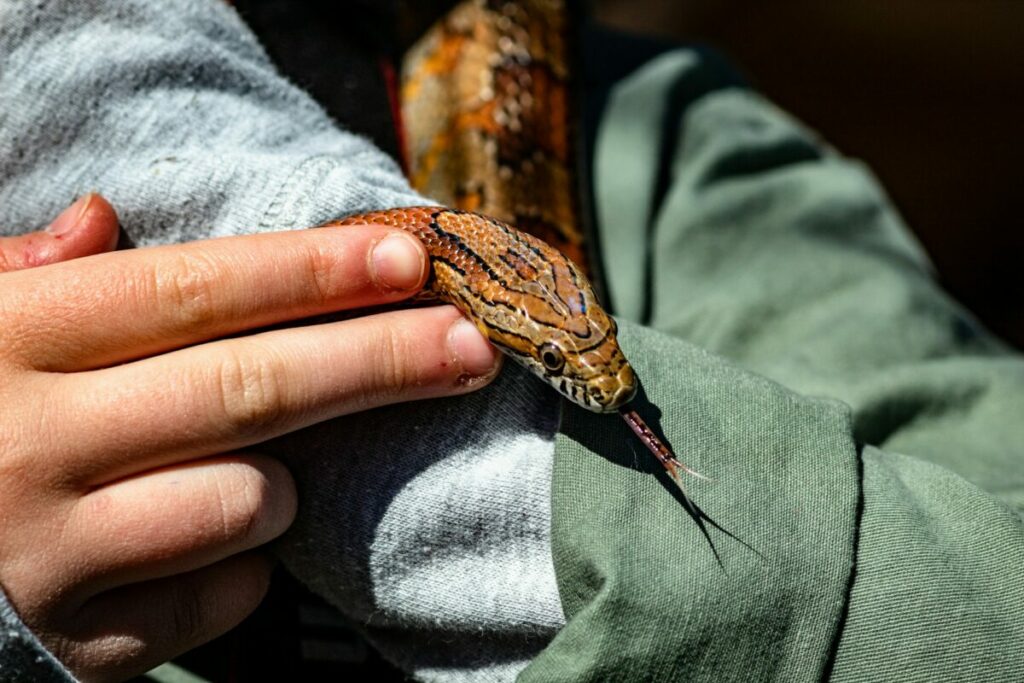
When selecting a corn snake, several key factors should be taken into account:
- Temperament: Different morphs can display varying temperaments, so it’s crucial to select a snake that matches your comfort level and handling experience.
- Care Requirements: Each morph may have specific care needs in terms of temperature, humidity, feeding habits, and enclosure size. Understanding these requirements is essential for providing proper care.
- Color and Pattern Preferences: With numerous color variations and patterns available, it’s essential to explore the diverse options and choose a snake whose appearance resonates with you.
It’s vital not only to consider your immediate preferences but also anticipate your long-term commitment as some morphs may live up to 20 years in captivity.
For instance, if you’re drawn to vibrant colors and intricate patterns, the palmetto morph’s unique appearance may make it an appealing choice. Its eye-catching pattern and distinctive coloration align with the preferences of enthusiasts seeking visually striking reptiles.
Before making a decision, thorough research is imperative. A reputable breeder or pet store can offer valuable guidance on selecting the right corn snake based on your preferences and experience level. By gathering insights from experts and fellow reptile enthusiasts, you can make an informed decision that aligns with your expectations.
If you’re looking for comprehensive insights and guidance on choosing the right corn snake for you, visit Interesting Animals for detailed information tailored to your specific needs and interests.
As you navigate through the diverse world of corn snake breeds, keep in mind that finding the perfect fit involves thorough consideration of temperament, care requirements, and personal preferences.
Embracing a pet like a corn snake can be incredibly rewarding once you find the ideal match for your lifestyle and preferences. Taking the time to understand these captivating creatures will ensure a fulfilling experience for both you and your scaly companion.